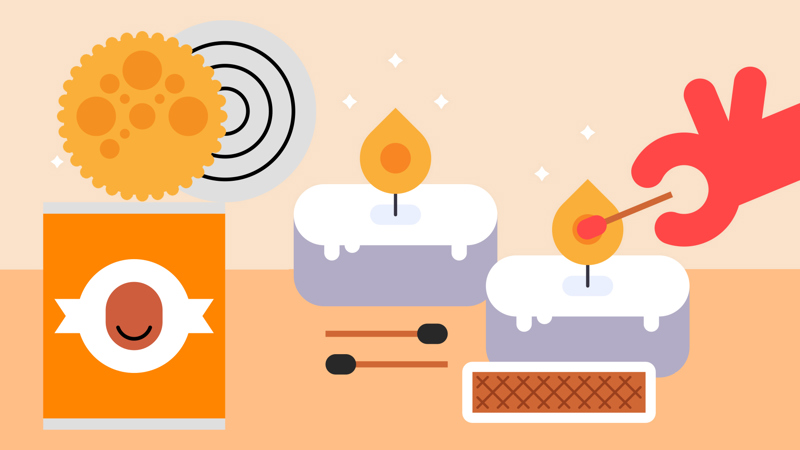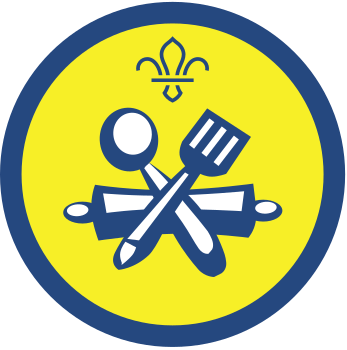
Make tin can pancakes
You’ll need
- Tin cans
- Tin openers
- Screwdrivers
- Tea lights
- Matches
- Plates
- Bowls
- Spoons
- Knives
- Ingredients, see below
- Heat-proof gloves
Before you begin
- Use the safety checklist to help you plan and risk assess your activity. Additional help to carry out your risk assessment, including examples can be found here. Don’t forget to make sure all young people and adults involved in the activity know how to take part safely.
- Make sure you’ll have enough adult helpers. You may need some parents and carers to help if you’re short on helpers.
Planning this activity
- You might find this activity easier using small low tin cans (smaller bean or spaghetti tins) with plenty of air holes, and extra tea lights under to help the pancakes cook.
- Remember to check for allergies, eating problems or dietary requirements and adjust the recipe as needed.
- Make sure you've checked everyone's dietary requirements and allergies then adapted the recipe as appropriate. This may include ensuring no cross-contamination during food storage, preparation and serving, too.
- Check if there are any items of food (or packaging) that people can’t touch or be near to or if there are items that people might not be comfortable using in the activity.
Make a tin can stove
- Make sure the tin can is empty, clean and dry. Take off any labels and check there’s no coating on the inside. Watch out for sharp edges on the open end of the can (the bottom of the can).
- Use a hammer and nail to carefully punch some holes in the side of the can near the top, so the end that’s still covered. With adult supervision, punch the holes all the way around. If you’re using a hammer and nail, slide the can onto a piece of secured timber so that the can stays still, and the nail goes into the wood.
- With adult supervision, gently place the screwdriver into each hole and wiggle it to make the holes a bit bigger. This’ll make sure enough oxygen circulates around the candle.
- Now, repeat steps two and three at the bottom of the can.
- Put the tea light on a plate and put the tin can stove over the tea light. Only light the tea light when you’re ready to use the stove.
Make your pancakes
Ingredients
- 200g flour
- Three tablespoons brown sugar
- One teaspoon baking powder
- 375-500ml milk
- One tablespoon oil
- One teaspoon vanilla extract (optional)
Mixing the ingredients
- Mix all of the dry ingredients in a bowl, then add the oil (and vanilla extract, if you’re using it).
- Gradually add the milk and mix it in. You may not need all of it – keep mixing and stop adding the milk when the batter’s the perfect consistency.
Cook the pancakes
- Use the matches to light the tea light and gently put the tin can stove on top.
- Add some oil to the top of the can and let it heat up. Remember, once you set the stove up it will be hot. Never touch it with your bare hands.
- If it needs to be moved, an adult should do this, wearing heatproof gloves or personal protective equipment.
- Test whether the oil’s hot enough by putting a dot of batter onto the tin can. If the oil’s ready, the dot of batter will start to cook. Remove the small bit of batter carefully with a table knife.
- Pour about a teaspoon of batter onto the top of the tin can stove. Once bubbles come to the surface, work the table knife around the edges of the pancake to loosen it so you can flip it over.
- If you need to hold the can steady, use a heatproof glove to protect your hand.
- Continue to flip the pancake over to make sure it cooks evenly on both sides. Once the pancake’s cooked, use the table knife to remove it.
- Once you’ve cooked your pancakes, add your favourite topping and taste them.
Reflection
Learning how to cook simple recipes that don’t use many ingredients or much equipment is a great skill for any budding adventurer. Why might this knowledge be helpful on expeditions or nights away? People could think about the importance of being able to create as many different and tasty meals as possible from a small amount of food and equipment. This makes it easier to pack lightly when camping or trekking.
Being able to cook basic meals is also an important step towards independence. Cooking with a limited number of ingredients can help people develop their creativity. Everyone should get into small groups and chat about other meals they could cook with the equipment and ingredients they have (and two or three added extras). Could they put these ideas to the test into an upcoming session?
Safety
All activities must be safely managed. You must complete a thorough risk assessment and take appropriate steps to reduce risk. Use the safety checklist to help you plan and risk assess your activity. Always get approval for the activity, and have suitable supervision and an InTouch process.
- Food
Remember to check for allergies, eating problems, fasting or dietary requirements and adjust the recipe as needed. Make sure you’ve suitable areas for storing and preparing food and avoid cross contamination of different foods. Take a look at our guidance on food safety and hygiene.
- Flammable items
Always take care when using flammable items, especially if you’re near fire. Always follow the manufacturer’s instructions and guidelines.
- Sharp objects
Teach young people how to use sharp objects safely. Supervise them appropriately throughout. Store all sharp objects securely, out of the reach of young people.
- Cooking
Teach young people how to use cooking equipment safely. Supervise them appropriately throughout. Make sure it’s safe to use and follow manufacturers’ guidelines for use.
- Fires and stoves
Make sure anyone using fires and stoves is doing so safely. Check that the equipment and area are suitable and have plenty of ventilation. Follow the gas safety guidance. Have a safe way to extinguish the fire in an emergency.
- We used an egg-free recipe to make it easier to split up the ingredients for people to make their own. If you have a tried and tested pancake recipe, why not try it out on your tin can stoves?
- It’s up to you whether young people make the stoves and mix the batter as well as cooking the pancakes. It’ll probably depend on the equipment you have and the age and experience of the young people.
It’s easy to adapt this recipe to avoid common allergens, for example, using gluten-free flour or a plant-based milk like soy milk.
All Scout activities should be inclusive and accessible.

